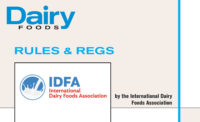The food industry has been fighting the deadly bacteria Listeria monocytogenes (Lm) for decades. Drawing on experience, science and technology, the industry has made great progress in devising strategies to prevent product contamination.
U.S. dairy products are among the safest in the world; however, we continue to see episodes of Lm contamination in dairy foods. To ensure greater success in our war on this pathogen, we need to have a strong understanding of the risks in individual plants and continuously learn from our experiences in order to improve our already strong food safety record.
For ready-to-eat (RTE) foods where in-package interventions (such as applying heat or controlling water activity or pH) cannot be used to prevent survival of Lm in or on a food, the only other way of protecting the food is to prevent the bacteria from gaining access to the food contact surface (FCS) of processing equipment and the finished RTE food in the first place.
This requires setting up a robust and dynamic environmental control and monitoring program that aims to seek out and destroy Lm in the RTE food plant environment. A part of this strategy includes defining hygienic zones around FCS. Typically, Zone 1 is the food contact surface, with Zones 2 to 4 radiating outward to non-production areas, according to the risk of transferring pathogens to the FCS. Using this zoning strategy, controls and monitoring activities are set-up according to each zone, and, therefore, the risk to the food.
Plants need good sanitary design
The first step towards developing an effective seek-and-destroy program is to make sure the Zone 1 food contact surfaces (particularly following any processing step that is lethal to Lm, such as pasteurization) are of good sanitary design. That means no niches, harborage or ingress points for the bacteria to hide or to enter from outside the line and be shielded from cleaning and sanitation chemicals.
Then, a processor needs to implement a good preventive maintenance program to ensure the line stays that way. Strong, effective controls in Zones 2 to 4 are worthless if you have loss of hygienic control inside a post-pasteurizer vat, valve or other juncture.
In some cases, once the integrity of Zone 1 is established and an effective food contact surface cleaning and sanitation program is demonstrated, a plant can focus primarily on monitoring and controlling Zones 2 to 4. However, in other cases, Zone 1 integrity may not be as secure, so a company may need to do more frequent Zone 1 FCS testing and/or finished product testing to verify that Zone 1 is being adequately controlled. This testing can involve looking for bacteria of the genus Listeria or other indicators of insanitary processing conditions.
Appropriate levels of controls, monitoring activities and corrective actions are established for each zone according to the risk of any Lm in that area reaching Zone 1. These may necessarily differ from plant to plant, depending on product and Zone 1 exposure and risk, plant conditions, history of findings, etc. Importantly, this concept of setting-up controls and appropriate testing regimes according to specific conditions directly aligns with the underlying principles imbedded within the FDA Food Safety Modernization Act and resulting Preventive Controls for Human Foods rule.
FDA’s new listeria control guidance
In an attempt to encourage this “seek and destroy” approach, the Food and Drug Administration earlier this year released a revised draft of “Control of Listeria monocytogenes in Ready-To-Eat Foods: Guidance for Industry,” which incorporates this same concept. The new FDA Guidance replaces an earlier draft from 2008. With the revised Guidance, FDA has moved to more closely align the agency’s thinking with that used within the food industry as well as the regulatory approach used by the U.S. Department of Agriculture’s Food Safety Inspection Service. FDA invited public comments on the draft by July 26, 2017, which IDFA provided.
As FDA works to review all the submitted comments, finalize its draft guidance and train its investigators, it will be critical, from our perspective, that FDA acknowledge the need for flexibility in how a particular facility (producing foods with specific properties, under unique conditions and with evolving experiences) will need to approach building and managing a Listeria control and monitoring program over time.
IDFA has concerns that a few of the recommendations as currently written are overly prescriptive and may not be the most practical and risk-based ways to manage risks of Lm for all dairy products. So, we look forward to continuing to exchange information with the agency on the best ways forward for our industry in light of our shared goal of seeking and destroying Lm and protecting our products and, most importantly, our consumers.

